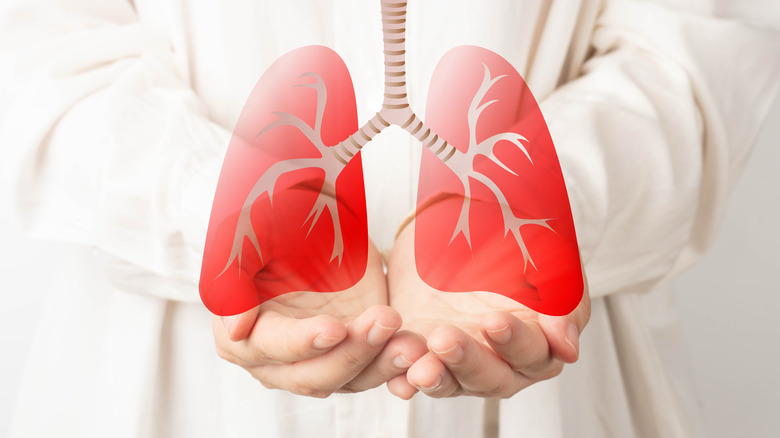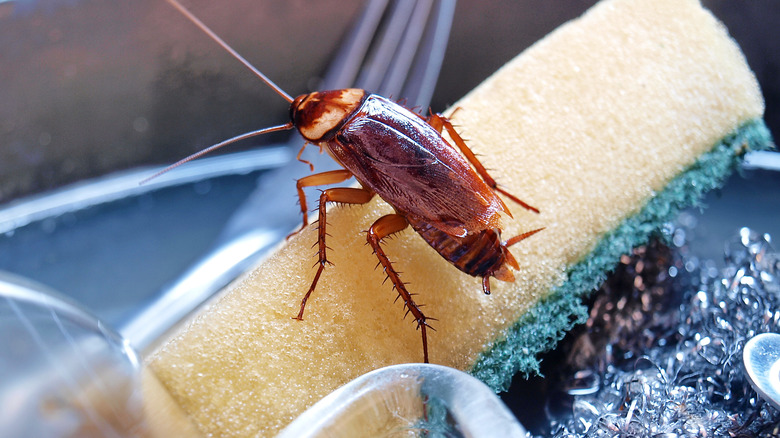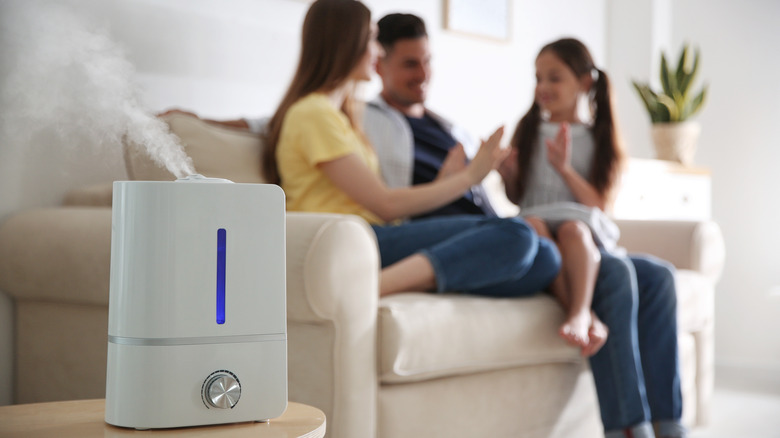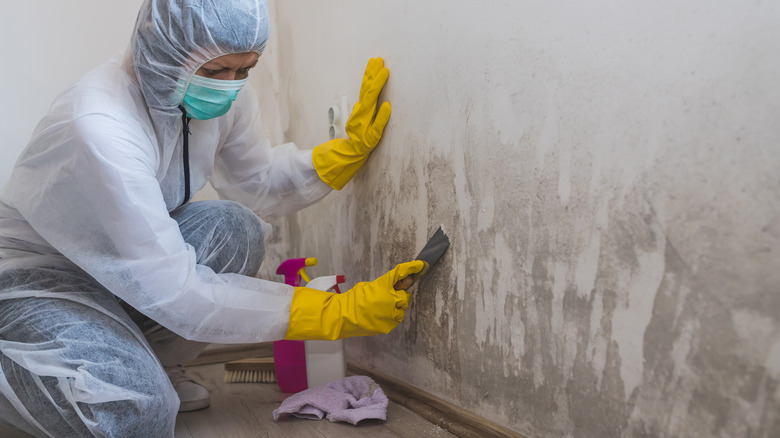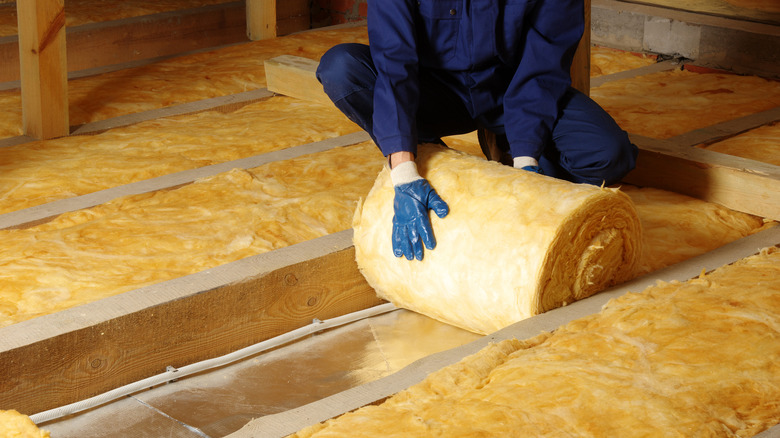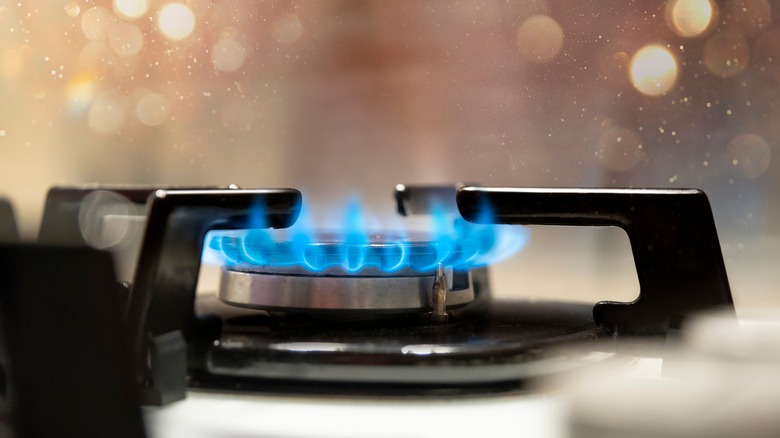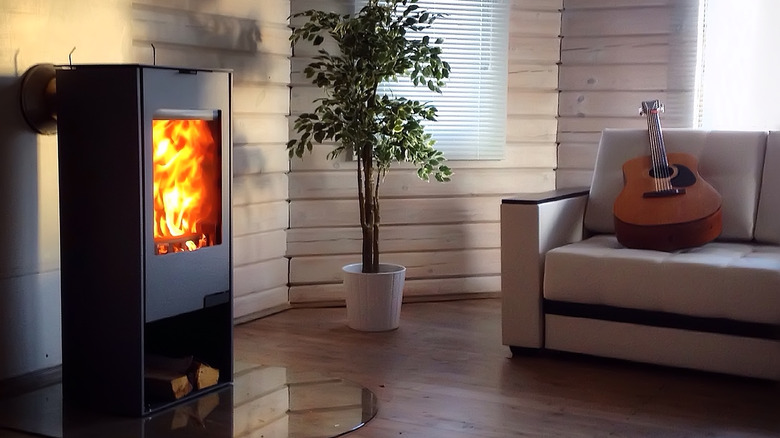14 Things You Didn't Realize Were Hurting Your Lungs
Your cells need oxygen to work and grow, and your lungs are how this essential element enters your body. It's healthy lungs that enable you to get the oxygen you need via the estimated 25,000 breaths you take daily. According to MedlinePlus, there are millions of people in the U.S. living with lung disease, and if you count all the types of this condition together, it's the third leading cause of mortality in the country.
Lung disease signs to watch out for include a cough that's lasted eight weeks or longer, shortness of breath, chronic mucus, and chronic chest pain, according to the American Lung Association (ALA). Other possible symptoms include wheezing and coughing up blood. The ALA recommends avoiding tobacco use as well as indoor and outdoor pollutants to protect your lungs. They also suggest exercise, regular healthcare checkups, and infection prevention as steps you can take to keep your lungs healthy.
It's easy to recognize pollutants like car exhaust or household cleaners as problematic for lung health. However, you may not think of baking ingredients or insects as being potential issues. It turns out, there's a few things to watch out for in your quest to protect your lungs.
Flour
Flour is a food staple and multi-billion-dollar global industry (via Business Wire). It's also a contributor to baker's allergy and asthma, according to an review in Current Opinion in Allergy and Clinical Immunology. The culprit is flour dust, which can increase the risk of allergic reaction, occupational asthma, and rhinitis. The World Allergy Organization points to wheat flour as producing the dust most commonly associated with baker's asthma.
Exposure can occur in various workplace settings, like supermarket bakeries and manufacturing plants. The risk is dose dependent, but the chance of allergic respiratory disease increases even at low concentrations of flour dust. If you work with flour on a regular basis, there are steps you can take to reduce your chance of developing baker's asthma (via Asthma.net). Wearing a mask as personal protective equipment is an effective way to reduce your inhalation of a large portion of the dust. If you can, opt for low-dust flour and liquid enzymes rather than powder, and make sure your work area is well ventilated.
Cockroaches
The Centers for Disease Control and Prevention (CDC) describe the hardiness of the cockroach as legendary. This tropical insect is nocturnal, so if you see them during the day, it can indicate a large infestation. They often gain access to your house through exterior cracks and crevices, and via boxes and bags of human and pet food. Once inside, they can move easily throughout your house in wall spaces and plumbing.
The CDC identifies the cockroach as an allergen source that can trigger asthma. The ALA adds that research is ongoing to explore the link between early cockroach allergen exposure and asthma in preschool-aged children. Cockroach allergen can still be present in your home even without the insects themselves. The ALA estimates that as many as one in five cockroach-free homes still contain the allergen, which may be airborne for a short while, but usually settles into surface dust or on fabric. The most common route of exposure is through contact with pillows and bedding.
Birds
There are many possible causes for shortness of breath and chest pain, but you might not expect your caged and feathered friend to be one of them. Bird fancier's lung (BFL) is a condition that can result from exposure to avian antigens found in bird droppings and waxy proteins that cover the feathers of some birds (via Respiratory Medicine Case Reports). BFL is a type of hypersensitivity pneumonitis, a condition that occurs when you breathe in substances that cause an allergic reaction.
BFL is the most common type of hypersensitivity pneumonitis, but it's often underdiagnosed. You can still develop this condition if you don't have any birds living in your home, since feather-filled bedding is a trigger for some people. You may even be susceptible if you're exposed to wild birds or those belonging to a neighbor, according to a report in Respirology Case Reports. Early diagnosis of BFL is important, because if it progresses without treatment, it can cause scarring. However, if your healthcare team catches it early enough, it's reversable.
Vaping
The chemicals you inhale while vaping cause an inflammatory response in your lungs, according to Johns Hopkins Medicine. E-liquid contains ingredients like flavorings and aromas, in addition to nicotine or THC (the psychoactive ingredient in marijuana). There are often other lung-damaging chemicals included, such as diacetyl, formaldehyde, and acrolein. All the ingredients are dissolved in an oily, liquid base that finds its way deep into your lungs.
If you vape regularly and experience symptoms like chest pain, coughing, wheezing, and shortness of breath, you may have developed bronchiolitis obliterans (BO), more commonly known as popcorn lung. BO occurs when the diacetyl in e-liquid causes inflammation that scars the smallest branches of your airways.
If you produce blood when you cough, it may be a sign of vaping-related lipoid pneumonia from inhaling the oil contained in e-liquid. Vaping can also contribute to lung collapse by rupturing weak spots some people have near the top of their lungs. These weak spots show no signs until they rupture, which is more likely to happen if a person smokes or vapes.
Fireworks
Fireworks wouldn't be the same without their vibrant colors, but it's those dazzling hues that create trouble for your lungs, according to the University of California San Diego Health. The colors appear thanks to metal salts (via EarthSky). The metals are toxic, dispersed into the air, and can damage your lungs. In addition to lead, fireworks often contain ingredients like copper, titanium, and strontium. Exposure times are short for most people, typically occurring only on the days of special events like New Year's Eve celebrations, but firework smoke is more toxic than typical daily air pollution.
IQ Air lists three categories of particulate matter (PM) pollution that result from fireworks: PM10 course particles, PM2.5 fine particles, and ultrafine particles (UFPs). UFPs are the smallest, comprise over 90% of airborne particle pollution, and are the most dangerous. Fireworks also create volatile organic compounds, which generate the smell in the air during and after the show. The pollutants linger for hours after the show is over and the sky is dark.
Airbags
Airbags save lives. They also contribute to asthma flares, new onset asthma, and other reactive airway disease, according to a report in Case Reports in Medicine. The cause is inhalational chemical pneumonitis from the particulate matter created when the airbag deploys. Airbags use chemical reactions and high temperatures to inflate. Sodium azide becomes sodium and nitrogen gas, which fills the airbag.
Merck Manual describes the symptoms of chemical pneumonitis as a sudden shortness of breath followed by the onset of coughing. You may also experience pink, frothy mucus and fever. In mild cases, it may take a day or two for symptoms to appear. If your symptoms are delayed, it's important to tell your doctor that you recently experienced airbag deployment. Treatment may include oxygen therapy, as well as intubation to allow for breathing machine assistance and trachea suctioning if necessary. Sometimes doctors prescribe antibiotics for the treatment of chemical pneumonitis because it can be difficult to distinguish it from bacterial aspiration pneumonia. Also, bacterial pneumonia can develop from chemical pneumonitis.
Humidifiers
Humidifiers can ease cold and respiratory symptoms, plus solve dry air issues like bloody noses and dry sinuses. They can also contribute to lung infections, according to Mayo Clinic. This problem arises when your humidifier isn't cleaned thoroughly and becomes a breeding ground for mold and bacteria. People who live with allergies and asthma may be more affected, but even those without any underlying respiratory conditions can develop lung infections from breathing contaminated humidifier air. Cool mist humidifiers are more likely to release airborne allergens than evaporators or steam vaporizers.
To prevent lung infections, Mayo Clinic recommends cleaning your humidifier every three days. Running your humidifier with distilled or demineralized water reduces the chance of mineral deposits that can encourage bacterial growth. Unplug it and change the water frequently, and wipe the inside surfaces dry each time to prevent film accumulation. If you've used chemicals to clean your humidifier, rinse it thoroughly afterward. If it has a filter, change it regularly.
Mold
Mold isn't just on surfaces. Particles can become airborne and affect anyone regardless of whether they live with allergies. The ALA lists coughing, wheezing, and worsening asthma among the unwanted lung impacts of dampness and mold. You may also experience symptoms like stuffy nose and itchy red eyes, according to the CDC. High occupational exposure, such as that of farm employees working near moldy hay, can result in severe reactions that include shortness of breath and fever.
A study by the American Academy of Pediatrics found a connection between early childhood mold exposure and the development of respiratory illness in children under six years of age. Physician diagnosed conditions included asthma and respiratory symptoms. The study found the strongest association with asthma among children who had moisture damage and visible mold in their bedrooms and living rooms.
Mold color isn't an indication of toxicity level. If you see mold spots of any kind, you should remove them and remedy the moisture problem that led to the mold growth. The CDC recommends removal and replacement of any porous material such as drywall or carpet that contains mold.
Carpet
A review published in the International Journal of Environmental Research and Public Health found that carpets can impact lung health by increasing the presence of allergens, dust, and microorganisms in your home. Asthma can result, as well as irritative symptoms and mild cognitive effects. Most of the studies in the review found a link between carpeted floors and adverse lung impacts like worsening asthma and respiratory infections.
Researchers also found an association between bedroom carpet and a higher chance of childhood asthma. They theorize that carpets hide dust and particulate because they're harder to clean than non-carpeted flooring. When there's activity on the carpet, the particulate matter may become airborne and inhaled.
According to the International Association of Certified Home Inspectors, carpet can also contain mold, which can produce allergens and mycotoxins. Whether you touch the carpet or inhale airborne allergens or spores, your lungs can pay the price with irritation and asthma symptoms.
Insulation
If you're planning a home renovation project involving insulation work, you might want to wait until you have the right personal protective equipment (PPE). An study published in the International Journal of Environmental Research and Public Health found an association between occupational exposure to insulating materials and respiratory illnesses like chest infections and chronic obstructive pulmonary disease (COPD).
Insulation contains potentially hazardous materials like fiberglass, aerogels, calcium silicate, other synthetic vitreous fibers like mineral and ceramic, and sometimes asbestos. The study found that aerogels and mineral fibers were the only two insulation materials not associated with an increased chance of chest infection. Meanwhile, asbestos was the only material connected to an increased prevalence of COPD, and none of the fibers were linked to asthma.
If you plan to work with materials that haven't been cleared as asbestos-free, the Minnesota Department of Health recommends wearing a respirator fitted with HEPA filtered cartridges. They advise against using paper dust masks, as they do not filter out asbestos.
Fragrance
It's unlikely that you'll get through an entire day without encountering fragrance somewhere. Whether it's in personal care products, cleaning products, or room scents, fragrance is a ubiquitous sensory agent designed to improve the human experience (via Air Quality, Atmosphere & Health).
While your olfactory receptors might appreciate synthetic scents, your lungs may not. The chemicals found in fragrance can make some people sick, according to the Canadian Lung Association. People who live with COPD, asthma, and other lung diseases may be particularly at risk for experiencing an adverse reaction to scents. In addition to symptoms like headache and dizziness, a reaction to fragrance can cause lung issues like shortness of breath and asthma flares.
It's the chemicals in fragrance that cause lung irritation for some people. Diethyl phthalate (DEP) is one such chemical. An study published in Environmental Research found that increasing levels of dermal DEP were connected to decreasing lung function. The association was partially because of immunological responses.
Gas appliances
If you use gas appliances like your stove or oven without proper ventilation, you could be hurting your lungs. According to the World Health Organization (WHO) Guidelines for Indoor Air Quality, this damage is because of nitrogen dioxide (NO2) and nitric oxide (NO), the two main nitrogen oxides that combustion sources produce. Since oxygen converts NO to NO2, it's the latter that comprises much of our combustion-related pollution. Combustion sources of NO2 include road traffic, tobacco smoke, and any kind of appliance that burns fuel like coal, wood, kerosene, oil, and gas.
The risk for childhood-onset asthma may be higher in homes that use gas appliances. A meta-analysis published in the International Journal of Epidemiology found that gas cooking increased the chance of asthma in children. The study also found that indoor NO2 increases the occurrence of wheezing. A review published in Environmental Health Perspectives found evidence of a connection between NO2 and lung cancer, although the exposure source in this case was outdoor pollution from traffic.
The WHO explains that since NO2 is a free radical, it may deplete antioxidant defenses in tissues, which can lead to injury and inflammation. The CDC adds that NO2 can increase your risk of infection by changing your immune system function. You can reduce these risks with proper ventilation while cooking by using a range hood, wall or ceiling exhaust fan, or open windows (via California Air Resources Board).
Hot tubs
A hot tub is a place to relax, unwind, and socialize with friends. Hot tub time can offer health benefits like stress reduction and increased circulation (via Healthline). It may also be a source of lung disease, according to a case study published in Cureus. The authors describe the case presentation of a hot tub user who experienced shortness of breath for several months, and a lung biopsy that was positive for Mycobacterium avium complex (MAC). Treatment of antimycobacterial therapy wasn't successful until the patient stopped using her hot tub.
Hot tub lung (HTL) is a rare condition that can result from inhalation of MAC and other non-tuberculous mycobacteria. The bacteria in question can exist in showers and swimming pools as well as hot tubs. Risk factors include poor hot tub maintenance, and insufficient ventilation. If you've developed HTL, you might experience symptoms like fatigue, shortness of breath on exertion, and weight loss. Your doctor can diagnose HTL by comparing your symptom duration with hot tub exposure, using imaging tests, and acquiring positive mycobacterial cultures from your lungs and a hot tub water sample.
Wood burning stoves
Wood burning stoves conjure up feelings of coziness and comfort and are a cost-efficient heat source for many people. However, the ALA cautions that they might not be safe for everyone. Wood smoke isn't good for anyone to breathe and may create more adverse effects in children and older adults, as well as people living with lung disease. Breathing wood smoke can trigger asthma flares, and cause coughing for some people.
Unlike cooking appliances, wood stoves often run continuously during the cold season. If your neighbors also use wood stoves, the ongoing venting from multiple homes can adversely affect your outdoor air quality. You can reduce your exposure by keeping your windows closed and using the fan setting on your air conditioning to recirculate indoor air through the A/C filter. If you can't switch from a wood burning stove to a cleaner heat source, the ALA suggests burning pellets and dryer wood to reduce the amount of smoke your stove produces.

